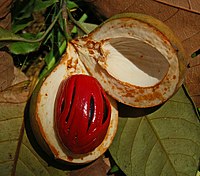
Photo from wikipedia
Programmed cell death (PCD) processes are essential in the plant embryogenesis. To understand how PCD operates in a developing seed, the dying cells need to be identified in relation to… Click to show full abstract
Programmed cell death (PCD) processes are essential in the plant embryogenesis. To understand how PCD operates in a developing seed, the dying cells need to be identified in relation to their surviving neighbors. This can be accomplished by the means of in situ visualization of fragmented DNA-a well-known hallmark of PCD. In the developing Scots pine (Pinus sylvestris L.) seed, several tissues die via morphologically different PCD processes during the embryogenesis. Here, we describe the protocols for the characterization of Scots pine seeds at the early and late developmental stages and, further, the localization of nucleic acids and DNA fragmentation by the acridine orange staining and TUNEL (terminal deoxynucleotidyl transferase (TdT)-mediated deoxyuridine triphosphate (dUTP) nick end labeling) assay in the dying seed tissues.
Journal Title: Methods in molecular biology
Year Published: 2020
Link to full text (if available)
Share on Social Media: Sign Up to like & get
recommendations!